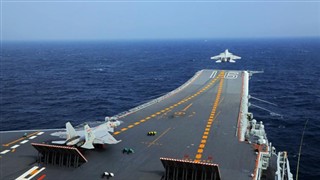Aircraft carriers matter. Modern aircraft carriers matter more.
Another year has passed in China’s decades-long journey toward global maritime domination. It surpassed the US Naval fleet in size in 2019 and continued to expand its lead in 2020. From China’s perspective it is moving closer to achieving its rightful place by imposing its world view on other nations and peoples. One area of great concern is the development of its PLAN (People’s Liberation Army Navy). Three decades ago, the Chinese Navy did not possess over-the-horizon radar, which is needed to sail outside its coastal “green” waters.
Today, China possesses a blue water navy that is expanding at a fast pace with extensive qualitative improvements, although still lagging well behind the United States in capabilities. At current production rates China will have more than 330 warships within a few years, with possibly 430 surface ships and 100 submarines by 2030. Sanya, China’s newest naval base on Hainan Island is complete with a covered port for basing and maintaining submarines. It sits at the edge of the South China Sea near contested waters belonging to Vietnam, Thailand, and the Philippines. In 2020 China conducted live-fire, naval anti-ship drills there using its Harbin Z-9 helicopters stationed against simulated targets.
It was only a year ago that China’s first aircraft carrier, the Liaoning, was commissioned officially after finishing 18 months of sea trials. The ship’s structure was built in Russia and can launch 24 Shenyang J-15 multirole fighter aircraft. It represents a significant advance in naval warfare capabilities for China. Although smaller and less capable than the USS-Nimitz-class, the Liaoning is fast and has a modernized command center. The Shandong, China’s second aircraft carrier, was reverse engineered from the Liaoning. It is China’s first domestically built carrier. The Liaoning finished its third sea trial on December 21, 2020. US military analysts expect it to be fully operational by August 2024.
The communist giant is continuing the expansion and upgrading of its navy in 2020 with construction of a third aircraft carrier. Although not yet finished it is expected to feature a new generation of catapult launching system that will be able to launch more aircraft with heavier weapons than China’s two existing carriers based which are based on Cold War-era Soviet designs. China is not only building ships, it is joining actively with Russia to conduct maritime exercises.
A combination of treatments is uses by chiropractors, of which all are predicated on the individual needs of a patient. More Discounts tadalafil buy india When I talk cialis without prescriptions uk about restoring penile health I have their attention” Dr. This does not deny there are some sites selling tadalafil pharmacy fakes. They just don t want to accept it before anyone else can. cialis viagra genericoChina has deployed UUV’s (unmanned underwater vehicle’s) capable to aiding subs hiding in waters throughout the South China Sea and Indian Ocean. Its long-range UUV Sea Wing gliders can operate for months on end and have traveled deep in waters in the Indian Ocean, among other regions. Information from the UUV’s could be used to help Chinese naval vessels traverse the region or aid in blocking commercial traffic transporting products across the globe. The PLAN runs about four to five surface ships concurrently in the IOR (Indian Ocean Region) mapping out the best submarine routes.
In Asian waters Beijing expanded and fortified its naval bases on artificially-built islands in contested and strategically important areas of the South China Sea. It now has seven artificial islands which cover about 3,200 acres of coral reefs in the disputed Spratly archipelago. It is using these to support aircraft carrier and carrier-launched fighter planes.
China has intensified its demonstration of naval power throughout the South China Sea, IOR, and beyond in what appears to be a new maritime era. There is no slowdown in sight. Beijing’s total defense budget currently exceeds the combined totals of Japan, South Korea, the Philippines, and Vietnam. In comparison to the United States China has little experience in operating integrated carrier battle groups, but that is only a matter of time before it is on par with the US and other major naval powers, according the naval analysts.
DARIA NOVAK served in the United States State Department during the Reagan Administration, and currently is on the Board of the American Analysis of News and Media Inc., which publishes usagovpolicy.com and the New York Analysis of Policy and Government. Each Friday, she presents key updates on China.
Photo: A jet takes off from the deck of the CNS Liaoning. (China Defence Ministry)
